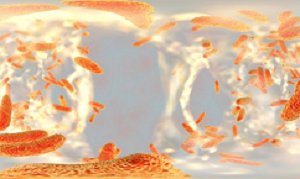 The spread of antimicrobial resistance in hospitals can be limited by sanitation methods that re-modulate the hospital microbiota, according to a multi-centre trial conducted in Italy. The new sanitation system was associated with a 83% decrease of the detected pathogens on hospital surfaces and a significant reduction (70-99.9%) of antimicrobial resistant genes.
The spread of antimicrobial resistance in hospitals can be limited by sanitation methods that re-modulate the hospital microbiota, according to a multi-centre trial conducted in Italy. The new sanitation system was associated with a 83% decrease of the detected pathogens on hospital surfaces and a significant reduction (70-99.9%) of antimicrobial resistant genes.
In particular, an experiment conducted in five Italian hospitals using the Probiotic Cleaning Hygiene System (PCHS), a trademarked probiotic-based sanitation method, coordinated by the CIAS research centre of the University of Ferrara, led to a 52% decrease in healthcare associated infections (HAI, a kind of infection that tend to exhibit higher resistance to antibiotics than community-acquired infections), a 60.3% reduction in associated drug consumption and a 75.4% decrease in the related costs.
"The results," Bocconi University's Rosanna Tarricone, co-author of the study, says, "suggest that the introduction of probiotic-based sanitation methods can be considered as a useful component of infection prevention strategies. Money saving are only a part of the story, as HAIs affect 3.2m people in Europe every year, resulting in 37,000 deaths."
The internal medicine wards of the hospitals enrolled in the study were surveyed for six months while using the conventional chemical-based sanitation method and, then, for a further six months using ecologically sustainable detergents containing spores of three Bacillus species. Overall 12,000 patients were included in the study and over 30,000 environmental samples from hospital surfaces were analysed.
The new sanitation system was associated with a mean 83% decrease of the detected pathogens on hospital surfaces and a significant reduction (70-99.9%) of antimicrobial resistant genes. In the case of Staphylococcus aureus (Staphylococcus spp. represented up to 90% of the total surface microbiota detected and S. aureus, in particular, plays an important role in HAIs), the isolates from the post-intervention phase were 63.9-93.5% less resistant to antibiotics, depending on the antibiotic type, and those resistant to three or more antibiotics decreased by 72.4%.
The number of healthcare associated infections diminished by 52%, as detailed in another co-authored paper and the cost per HAI episode diminished by 45.6%, translating into the aforementioned 60.3% reduction in associated drug consumption and 75.4% decrease in related costs.
Since the analysis focused only on drug costs, "taking into account other variables, such as the length of stay in hospital, our estimates of the savings are likely to be conservative," concludes Carla Rognoni, the other Bocconi University co-author of the paper.
Abstract
Purpose: Antimicrobial resistance (AMR) is one of the major threats to human health, and the high frequency of resistant pathogens in the hospital environment can contribute to the transmission of difficult-to-treat health care-associated infections (HAIs). We recently reported that, compared with conventional chemical cleaning, the use of a microbial-based sanitation strategy (Probiotic Cleaning Hygiene System [PCHS]) was associated with remodulation of hospital microbiota and reduction of HAI incidence. Here, we aimed to analyze the impact of PCHS on AMR and related effects, such as HAI-associated antimicrobial drug consumption and costs.
Patients and methods: Five Italian hospitals, enrolled in a multicenter study where conventional sanitation methods were replaced with PCHS, were included in the analysis. The study period included a 6-month observation for each sanitation type. Surface microbiota AMR was analyzed using microarray, nested PCR, antibiogram, and microdilution tests. Drug consumption data and related costs were obtained from the medical records of all hospitalized patients affected by HAIs.
Results: PCHS use was associated with up to 99% decrease of the AMR genes harbored by surface hospital microbiota, independently of the resistance types originally present in each individual setting (Pc<0.01). Functional assays confirmed the molecular data, demonstrating a 33%–100% decrease of resistant strains depending on the antibiotic type. Antimicrobial drug consumption associated with HAI onset showed a global 60.3% decrease, with a 75.4% decrease of the associated costs.
Conclusion: The spread of AMR in the hospital environment can be limited by the use of sanitation methods to remodulate the hospital microbiota, leading to lower antimicrobial consumption and costs. This approach might be considered as part of broader infection prevention and control strategies.
Authors
Elisabetta Caselli, Luca Arnoldo, Carla Rognoni, Maria D'Accolti, Irene Soffritti, Luca Lanzoni, Matteo Bisi, Antonella Volta, Rosanna Tarricone, Silvio Brusaferro, Sante Mazzacane
[link url="https://www.knowledge.unibocconi.eu/notizia.php?idArt=20448"]Bucconi University material[/link]
[link url="https://www.dovepress.com/impact-of-a-probiotic-based-hospital-sanitation-on-antimicrobial-resis-peer-reviewed-article-IDR"]Infection and Drug Resistance abstract[/link]
